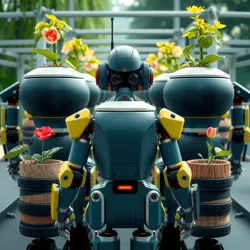Symbiotic Systems

Symbiotic Systems refer to the integration of natural and technological elements to create cooperative and mutually beneficial networks. These systems are designed to mimic the symbiotic relationships found in nature, where two or more entities coexist and support each other's survival and growth. In the context of modern technology, symbiotic systems aim to enhance sustainability, efficiency, and harmony between artificial and natural components.
Origins and Development
The concept of symbiotic systems originated from the study of symbiotic relationships in biology, where organisms such as plants, animals, and fungi engage in mutually beneficial interactions. Inspired by these natural phenomena, researchers and engineers began to explore how technology could be designed to work alongside natural systems rather than disrupt them. This led to the development of technologies like plant-based robotics and photosynthetic machines, which leverage biological processes for energy and functionality.
Key Components
Biological Integration
At the heart of symbiotic systems is the seamless integration of biological elements. This involves using living organisms or biological processes to perform specific functions within a technological framework. For example, the Institute of Photosynthetic Machines has developed robots that utilize photosynthesis, allowing them to operate efficiently in sunlight-rich environments.
Technological Innovation
Symbiotic systems also rely on cutting-edge technology to facilitate interaction and cooperation between natural and artificial components. This includes advanced sensors, AI algorithms, and autonomous systems that can adapt to changing environmental conditions. These technologies are often showcased at events like the Automated Harmony Symposium, where the focus is on the fusion of robotics and natural systems.
Mutual Benefits
The primary goal of symbiotic systems is to ensure that all participating elements benefit from the interaction. This is achieved by designing systems that enhance resource efficiency, reduce waste, and promote ecological balance. For instance, the Symbiobotanic Gardens serve as living examples of how robotic caretakers and plants can coexist to create self-sustaining ecosystems.
Applications and Impact
Symbiotic systems have a wide range of applications across various fields, including agriculture, urban planning, and environmental conservation. In agriculture, initiatives like the Robotic Gardeners of Eden demonstrate how technology can aid in sustainable food production. In urban environments, symbiotic systems are being implemented to create green spaces that support biodiversity and improve air quality.
Educational and Cultural Influence
Beyond practical applications, symbiotic systems have significant cultural and educational implications. They challenge traditional views of technology as separate from nature, encouraging a more integrated and holistic approach to innovation. Programs and workshops in settings like the Symbiobotanic Gardens educate the public on the importance of symbiotic relationships and inspire a new generation of thinkers to pursue sustainable solutions.
Future Prospects
The future of symbiotic systems is promising, with ongoing research and development poised to unlock new possibilities for integration. Emerging trends include the exploration of Symbiotic Sound Waves, which aim to blend auditory experiences with natural processes in innovative ways. As these systems continue to evolve, they hold the potential to redefine how humans interact with technology and the natural world, fostering a more sustainable and harmonious existence.
See Also
- Institute of Photosynthetic Machines
- Automated Harmony Symposium
- Symbiobotanic Gardens
- Robotic Gardeners of Eden
References
- "Symbiotic Systems: Bridging Nature and Technology," Journal of Eco-Innovation, 2056.
- "The Role of AI in Symbiotic Relationships," Proceedings of the Technology-Ecology Conference, 2057.
- "Sustainable Futures: The Promise of Symbiotic Systems," Journal of Environmental Science, 2058.